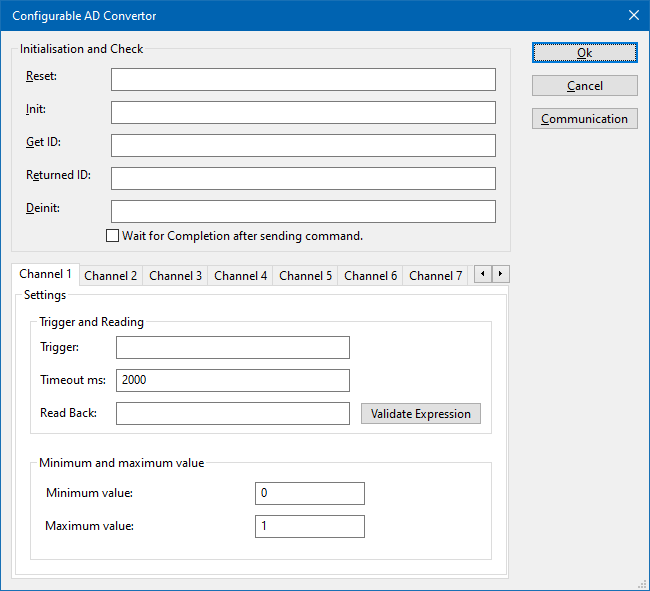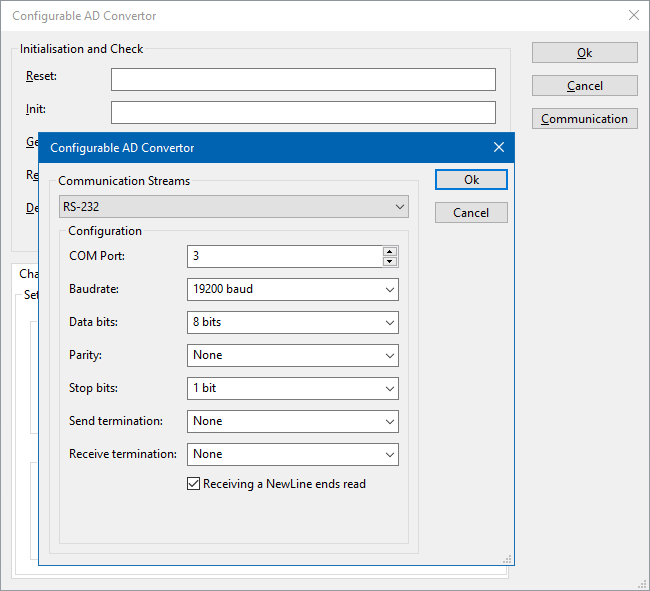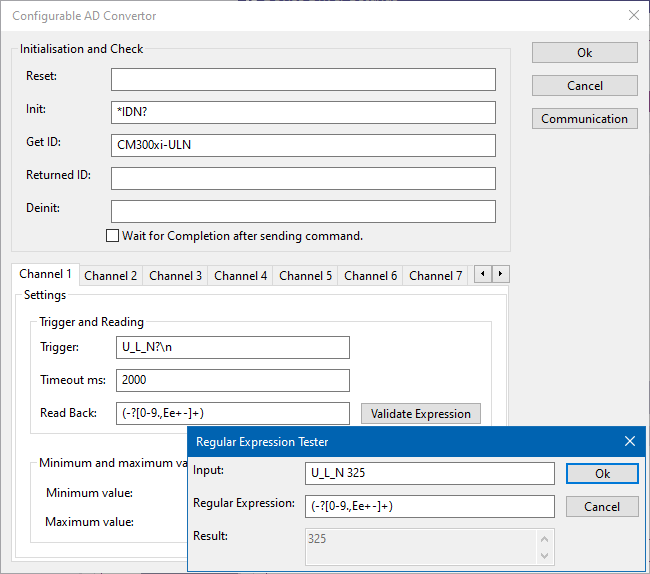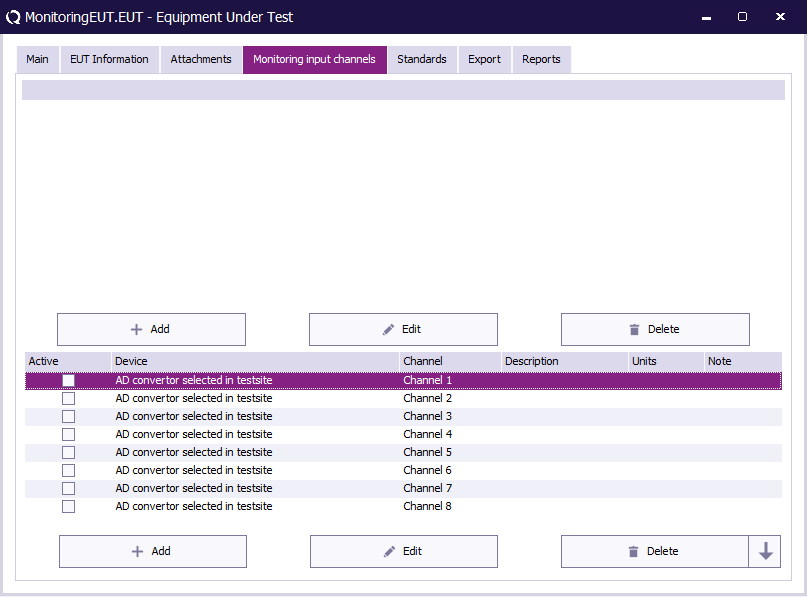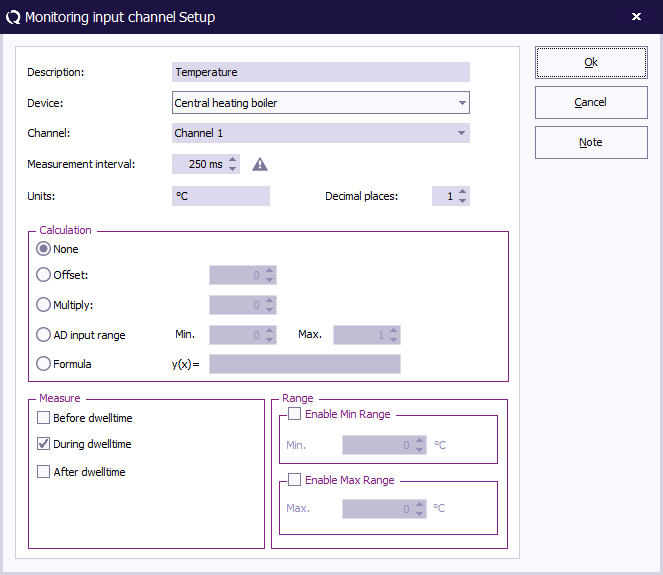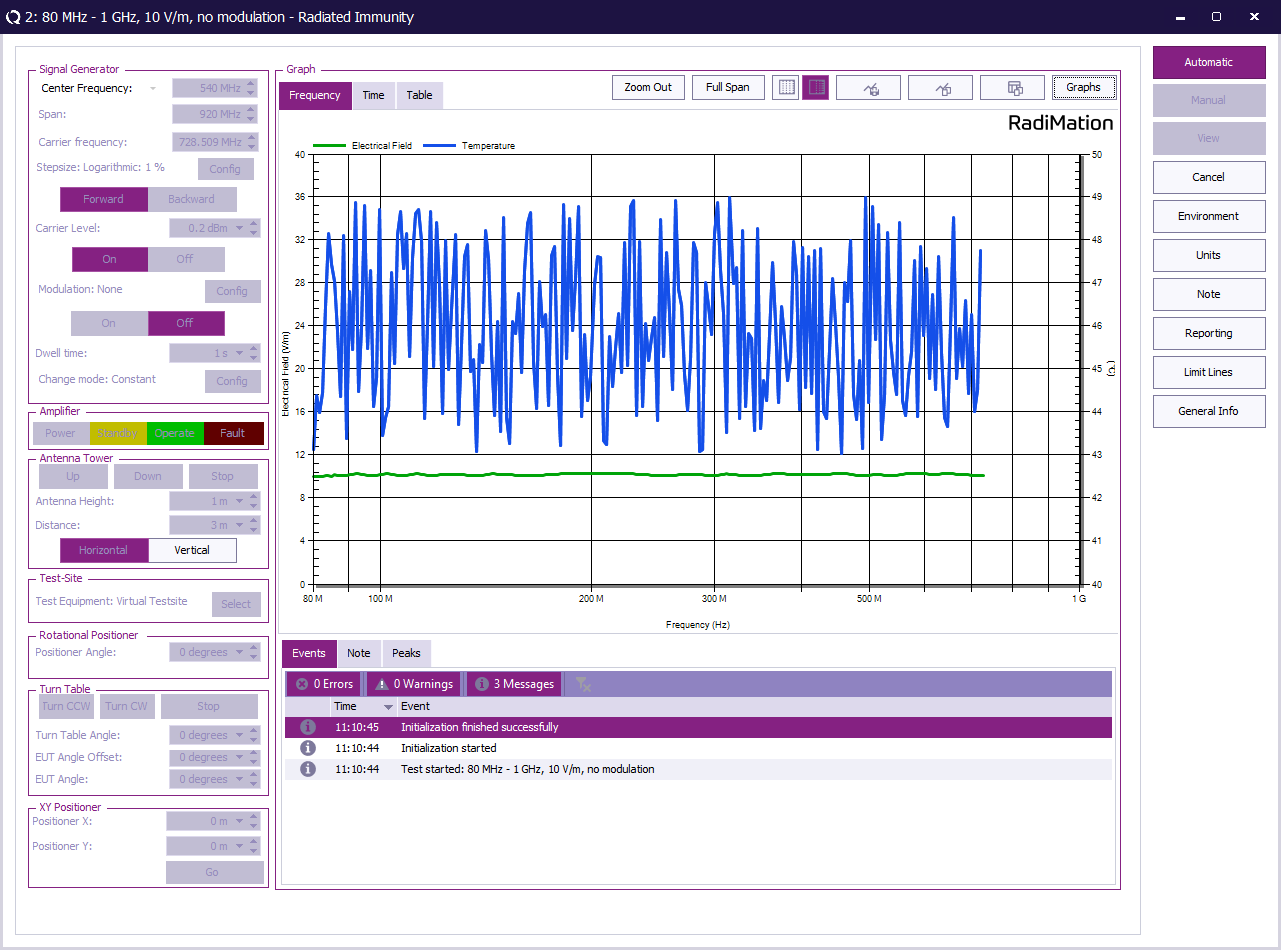RadiMation Application Note 114: Difference between revisions
| Line 23: | Line 23: | ||
{{ScreenElementDescription|Init|The command that is transmitted to initialize the configured device. When left blank no command will be transmitted.}} | {{ScreenElementDescription|Init|The command that is transmitted to initialize the configured device. When left blank no command will be transmitted.}} | ||
{{ScreenElementDescription|Get ID|The query-command that is transmitted to retrieve the ID of the device. This is used to check if the device is connected. A commonly used [[SCPI]] command is: *IDN?. When left blank, no command will be transmitted.}} | {{ScreenElementDescription|Get ID|The query-command that is transmitted to retrieve the ID of the device. This is used to check if the device is connected. A commonly used [[SCPI]] command is: *IDN?. When left blank, no command will be transmitted.}} | ||
{{ScreenElementDescription|Returned ID|The expected response on the 'Get ID' query. The text that is specified will be searched in the real response on 'Get ID' query. If the specified text can be found in the response, the check for the connecton is succesfull, otherwise it is reported that the measurement device is not connected. Leaving this blank, will skip the check if the measurement device is connected, and it is always assumed that the device is connected..}} | {{ScreenElementDescription|Returned ID|The expected response of the device on the 'Get ID' query. The text that is specified will be searched in the real response on 'Get ID' query. If the specified text can be found in the response, the check for the connecton is succesfull, otherwise it is reported that the measurement device is not connected. Leaving this blank, will skip the check if the measurement device is connected, and it is always assumed that the device is connected..}} | ||
{{ScreenElementDescription|Deinit|Specifies the command that is transmitted when the device will not be controlled anymore.This can for example be used to put the measurement device in an intrinsic safe state. when left blank, no command will be transmitted.}} | {{ScreenElementDescription|Deinit|Specifies the command that is transmitted when the device will not be controlled anymore.This can for example be used to put the measurement device in an intrinsic safe state. when left blank, no command will be transmitted.}} | ||
{{ScreenElementDescription|Wait for Completion after sending command| | {{ScreenElementDescription|Wait for Completion after sending command|If the checkbox is ticked, {{RadiMation}} will wait for all the commands to complete, before it continues. This is achieved by also transmitting the [[SCPI]] query-command '*OPC?' to the device, and waiting for the response.}} | ||
{{ScreenElementDescriptionEnd}} | {{ScreenElementDescriptionEnd}} | ||
Revision as of 20:56, 2 February 2020
How to measure data from the EUT using the Configurable AD Convertor device driver[edit]
This Application Note explains how the Configurable AD Convertor can be used to monitor an EUT. With the AD convertor, any type of signal can be monitored and plotted within RadiMation during an immunity test.
The configuration can be seperated in two steps:
- Configure the Configurable AD Convertor device driver to retrieve the values from the measurement device.
- Plot the value during an immunity test using the correct unit.
Configuring the Configurable AD convertor[edit]
Create a new Configurable AD Convertor device driver. It is best to give this new device driver a descriptive description to identify it clearly for the task that it is used for. After the device driver is created, open the 'Advanced' settings window of the new device driver.
Specify the communication type[edit]
First the correct settings for the communication with the measurement device must be configured. The Configurable AD Convertor supports several communication types, which can be used to communicate with the measurement device. Depending on the connection that is used, select the correct Communication Stream, and configure the parameters correspondingly to communication settings that are used by device.
Configure the initialization of the device[edit]
The Configurable AD Convertor device driver has several boxes, in which remote programming commands can be specified, which should be transmitted to the measurement device on defined moments.
| The reset code that needs to be transmitted to device. When left blank, no command will be transmitted. |
| The command that is transmitted to initialize the configured device. When left blank no command will be transmitted. |
| The query-command that is transmitted to retrieve the ID of the device. This is used to check if the device is connected. A commonly used SCPI command is: *IDN?. When left blank, no command will be transmitted. |
| The expected response of the device on the 'Get ID' query. The text that is specified will be searched in the real response on 'Get ID' query. If the specified text can be found in the response, the check for the connecton is succesfull, otherwise it is reported that the measurement device is not connected. Leaving this blank, will skip the check if the measurement device is connected, and it is always assumed that the device is connected.. |
| Specifies the command that is transmitted when the device will not be controlled anymore.This can for example be used to put the measurement device in an intrinsic safe state. when left blank, no command will be transmitted. |
| If the checkbox is ticked, RadiMation® will wait for all the commands to complete, before it continues. This is achieved by also transmitting the SCPI query-command '*OPC?' to the device, and waiting for the response. |
Configure the data readout of the device[edit]
AD convertors can have multiple channels on which AD values could be read. The Configurable AD Convertor device driver is able to retrieve up to 40 measurement values from the measurement device. For each AD channel, individual commands can be set, specific for the values that should be retrieved.
Trigger and Reading[edit]
| A trigger command can be specified to request a measurement from the device. A commonly used SCPI command is: *TRG. When left blank, no command will be send. |
| Different measurement devices will return different messages that contain the measurement value. The configurable AD convertor only needs the numeric value of the measurement device response. The text that is specified in the Read Back box, is used as a regular expressions to determine the returned value.
A good regular expression for finding the first number in scientific notation in a text is: ([+-]?[0-9]*\.?[0-9]+([eE][+-]?[0-9]+)?) For more possibilities see the example section. |
| Shows a window where the expected output of the measurement device and a regular expression can be typed. The result of the interpretion will then automatically be shown. This window can be used to test the regular expression, to determine if the expected response results in the desired value. |
Minimum and maximum value[edit]
Minimum and maximum can be set to limit the measured value. And to calculate the measured value to a specific unit.
| The lowest value that can be measured with this device. The value must be the same as filled in the EUT window. |
| The highest value that can be measured with this device. The value must be the same as filled in the EUT window. |
These values can best to always be set to Minimum: 0 and Maximum: 1
Read Back examples[edit]
Received information
|
Regex
|
RadiMation Readout
|
Note
|
|---|---|---|---|
| U_L_N 325 | (-?[0-9.,Ee-]+)
|
325
|
Takes the first number.
|
| I_L1;12.34 | ;(-?[0-9.,Ee-]+)
|
12.34
|
Takes the first number after ";".
|
| THD_U_L1;;14,5 | ;;(-?[0-9.,Ee-]+)
|
14.5
|
Takes the first number after ";;".
|
| AC_FREQ;Channel1;1.23E3 | ;.*;(-?[0-9.,Ee-]+)
|
1230
|
Takes the first number after the appearance of a second ";".
|
Read backs can always be tested trough the Validate Expression tool.
Plotting the AD Convertor data with the correct unit type[edit]
Create a new monitoring input channel[edit]
- The monitoring functionality is applied to the EUT. Therefor we first need to have an EUT file opened.
- In the opened EUT file, we can select the Monitoring input channels tab.
- Double click an existing input channel or add a new input by using the add button.
- A new window will open to configure the monitoring input channel.
Configure a monitoring input channel[edit]
- At the device menu, the newly configured AD convertor can be selected.
- The selected AD channel must be selected.
- The Unit type can be specified as text.
- With Calculation, the raw value from the AD convertor can be modified to match the preferred unit. More information can be found here.
- The Monitoring Input channel description will be shown in the graph title.
- After pressing Ok to save the configurations, ensure that the configured monitoring channel is marked as Active in the monitoring input channels list.
Running a test[edit]
When a test is run, RadiMation will also measure the value from the measurement device and it will plot the line(s) of the activated monitoring input channel(s). By switching to the Table tab, the measurement values will be shown in a tabular style.
